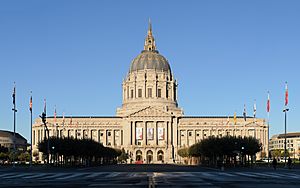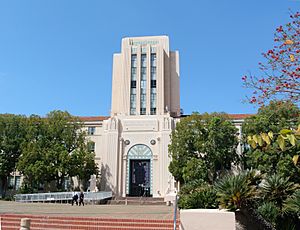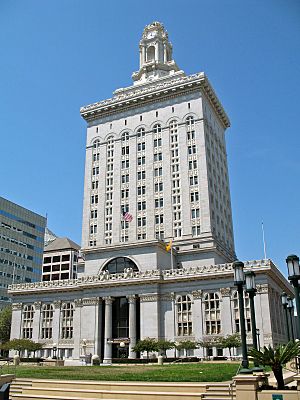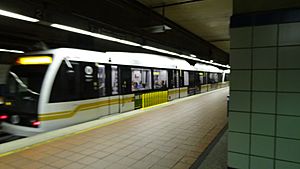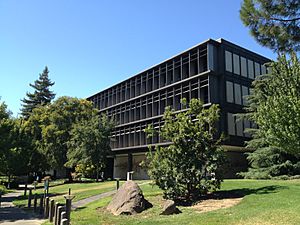Local government in California facts for kids
California has a big and sometimes tricky system for how local governments work. These governments help manage public services all over the state. California is split into 58 areas called counties, including San Francisco. These counties cover the whole state.
Most cities are "incorporated," meaning they have their own local government. But not all of California is inside a city. School districts are separate from cities and counties and handle public education. Many other services, especially in areas not part of a city (called unincorporated areas), are handled by special groups called special districts. These can include groups that manage water, public transportation, or even mosquito control.
The money cities and counties get from property tax and sales tax can be different depending on the area. This means the services offered might also vary from one city or county to another.
In California, elections for county, city, school, and court jobs are non-partisan. This means political parties are not listed on the ballot for these local elections.
Contents
Counties: How They Help Your Community
The main local government areas in California are its 58 counties. County governments provide many services for everyone in the county.
What Counties Do for You
Counties handle important services like:
- Law enforcement and jails.
- Running elections and registering voters.
- Keeping important records like birth certificates and property deeds.
- Collecting taxes.
- Public health and healthcare services.
- Social services and libraries.
- Controlling floods and providing fire protection.
- Animal control.
- Making sure building rules are followed.
- Ambulance services.
- Helping maintain statewide education standards.
For areas not part of any city (called unincorporated areas), the county acts as the local government. This means they provide police, parks, street maintenance, and waste disposal in those areas. Counties can also make their own local rules, called ordinances. Breaking these rules can be a misdemeanor (a less serious crime).
| County | Largest City | Government |
|---|---|---|
| Alameda | Oakland | Alameda County |
| Fresno | Fresno | Fresno County |
| Los Angeles | Los Angeles | Los Angeles County |
| Sacramento | Sacramento | Sacramento County |
| San Diego | San Diego | San Diego County |
| San Francisco | San Francisco | |
| San Joaquin | Stockton | San Joaquin County |
| Solano | Vallejo | Solano County |
| Stanislaus | Modesto | Stanislaus County |
How Counties Are Run
Most counties in California are run by an elected five-member Board of Supervisors. These supervisors hire people to manage the county's different departments. San Francisco is special because it's both a city and a county. It has an eleven-member Board of Supervisors and an elected mayor who leads the executive branch.
All counties elect their district attorneys and their sheriffs. The sheriff is usually in charge of the county jail.
County Courts
California's court system is set up along county lines. However, the county courts are actually part of the state court system, not the county government. Counties used to be responsible for providing courthouses and security. Now, the state government manages the courthouses. Counties still help by providing deputy sheriffs for security in the courthouses.
Local Agency Formation Commissions (LAFCOs)
Each county has a special group called a Local Agency Formation Commission (LAFCO). A LAFCO helps manage how new special districts are created. It also oversees how unincorporated land (land not in a city) gets added to existing cities. A city cannot cross county lines.
Grand Juries in Counties
California also uses grand juries. There is at least one in each county. These are often called civil grand juries. Their main job is to check on how local government groups are working. They meet at least once a year.
A Little History of Counties
The first 18 counties in California were formed on January 4, 1850. The last county to be created was Imperial County on August 7, 1907. Since 1911, counties have had some "home rule." This means they can make some decisions for themselves. The Government of Los Angeles County was the first in the nation to get this power in 1912.
Cities and Towns: Your Local Hubs
As of 2011, California had 482 incorporated cities and towns. In California law, the words "city" and "town" mean the same thing. So, a place can be called "City of (Name)" or "Town of (Name)." In areas not part of a city, the county government handles city-like powers.
| City | County | Government |
|---|---|---|
| Los Angeles | Los Angeles | Los Angeles |
| San Francisco | San Francisco | |
| Sacramento | Sacramento | Sacramento |
How Cities Are Run
California cities are either "charter" or "general-law." General-law cities follow rules set by the state. Charter cities can have more powers, but their rules need to be approved by a public vote.
Most smaller cities use a "council-manager" system. Here, the elected city council hires a city manager to run the city's daily operations. Some larger cities have a directly elected mayor who leads the city government. In many council-manager cities, the city council chooses one of its members to be mayor. This mayor's role is mostly ceremonial.
What Cities Do for You
Incorporated cities and towns can collect taxes. They are responsible for:
- Providing police services.
- Managing zoning (rules about land use).
- Issuing building permits.
- Maintaining public streets.
Cities can also provide parks, public housing, and some utility services. However, these services are sometimes handled by special districts or private companies. Cities can also make their own local rules, called ordinances. Breaking these rules can be a misdemeanor.
Becoming a City
If enough people live in an unincorporated area of a county, they can vote to create their own city. When a city is formed, it takes some of the tax money that would have gone to the county. The new city can then choose to provide most services itself. Or, it can pay the county to keep providing some services. A city that pays the county for services is called a contract city. This idea started with the city of Lakewood in 1954.
Special Districts: Focused Services
A special district is a group that provides specific government services within a certain area. Most special districts in California focus on just one service. Most of them do not have police powers.
Types of Special Districts
- Independent special districts have elected boards that make decisions.
- Dependent special districts are run by the city or county that created them.
- Regional bodies have boards chosen by the city and county governments they serve.
Some districts, called assessment districts, base voting on the value of property in the district. This is allowed for districts that provide benefits to the land itself.
Districts are also split into enterprise districts and non-enterprise districts. Enterprise districts act like a business. They get most of their money from fees for services or selling products. Examples include districts that provide water, waste disposal, electricity, hospitals, or public transportation.
Common Special Districts
The most common type of special district is the utility district. These provide services like water, electricity, or waste management. Big examples include the Sacramento Municipal Utility District (electricity) and the Metropolitan Water District (water for the Los Angeles area).

Another common type is the transit agency, which provides public transportation. The Los Angeles County Metropolitan Transportation Authority offers bus and train services. The San Francisco Bay Area Rapid Transit District (BART) runs commuter trains.
There are thousands of special districts in California. They spend billions of dollars each year to provide services.
Examples of Special Districts
Here are some types of special districts you might find:
- Air pollution control districts
- Airport districts
- Bridge or highway districts
- Community services districts
- Fire protection districts
- Harbor and port districts
- Health care districts
- Irrigation districts (for water to farms)
- Library districts
- Mosquito abatement districts
- Municipal utility districts (for utilities like water or power)
- Recreation and park districts
- Sanitary districts (for sewage)
- School districts (though often considered separate)
- Transit or rapid transit districts

Images for kids
-
Fresno City Hall, where the Fresno City Council meets
-
The main building of Mission College of the West Valley-Mission Community College District in Santa Clara


